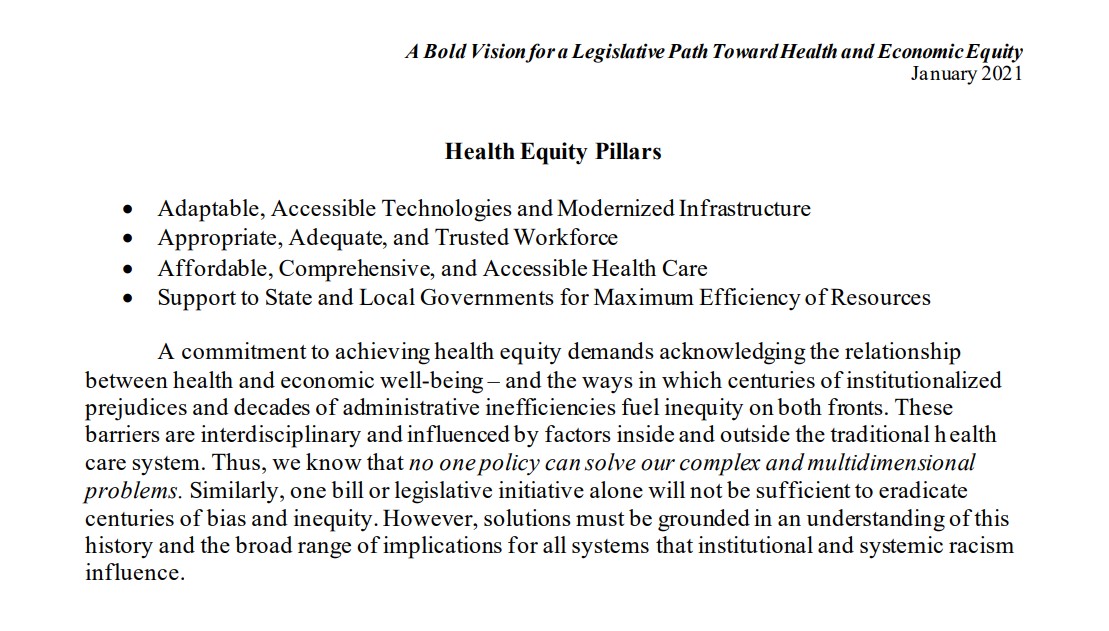“Health does not exist in a vacuum, and achieving health equity will require addressing the economic and social inequities that have long persisted within our country.”
This statement is from the Introduction to a new Ways and Means Committee Report, entitled Something Must Change: Inequities in U.S. Policy and Society. It was released this week, along with a document outlining policy pillars and priorities, A Bold Vision for a Legislative Pathway Toward Health and Economic Equity.
I wrote back in September about House Ways and Means Chairman Richard E. Neal, who had written a series of letters to medical leaders. These letters were about addressing the longstanding racial inequities in US society. In these letters, Chariman Neal asserts that “As clinicians, health equity scholars, and medical professional societies continue to work toward eliminating racial health inequities, the consequences to health and the perpetuation of unequal outcomes make this work more urgent than ever. We must redouble our efforts.”
Chairman Neal followed this up, as I shared later in September, with an open Request for Information about “the misuse of race within clinical care.”
It was positive news this week, then, to hear about the outcomes of these requests.
In an email announcing the press release and reports, the Health Staff of the Ways and Means Committee Democrats expressed their hope that people would “review and lift up this important work, and consider the important points it raises as we move forward in the 117th.”
It’s in that spirit that I’m sharing this news with you.
From the press release:
WASHINGTON, DC – Today, House Ways and Means Committee Chairman Richard E. Neal (D-MA) released a new legislative framework for how the Committee will address the role that racism, ableism, and other social, structural, and political determinants have in perpetuating health and economic inequity in the United States. The framework is placed into context in a Democratic Committee staff-prepared report that examines the history and intersection of federal policy and inequities in the United States.
The report, entitled “Something Must Change: Inequities in U.S. Policy and Society,” provides key context on which members’ legislative priorities are based, and the framework, entitled “A Bold Vision for a Legislative Path Toward Health and Economic Equity,” lays out pillars and policy priorities focused on achieving equity in health and the economy that will steer the Committee’s work in the 117th Congress and beyond. The COVID-19 pandemic’s uneven impact on communities across the nation has highlighted the urgency with which the Committee must act, just as last week’s tragic insurrection at the U.S. Capitol starkly illustrated the vastly different treatment certain populations receive from law enforcement and other institutions.
In their email, the Health Staff of the Ways and Means Committee Democrats pointed out that “These documents build on the Committee’s work in the 116th Congress with the Rural and Underserved Communities Health Task Force and the report Left Out: Barriers to Health Equity for Rural and Underserved Communities.”
They also added that “these two reports examine critical issues across the Ways and Means Committee as a whole, and are not limited solely to health.”
I think it’s safe to say that people who read this site and listen to our podcast series are well aware that you cannot talk about health without talking about income, and vice versa. So “Health and Economic Equity,” though a bold goal, at least states the obvious: we won’t have one without the other.
But why Ways & Means? The Something Must Change: Inequities in U.S. Policy and Society report Introduction offers this explanation:
“As the committee with jurisdiction over health, tax, and trade policy, as well as social safety net programs, the Ways and Means Committee is well-positioned to address the role that racism, ableism, and other social, structural, and political determinants play in perpetuating health and economic inequity.”
I hope you will read the Framework and the two Reports. I thought I’d whet your appetite by sharing what the Framework calls the 4 “Health Equity Pillars.” These four pillars are elaborated on, later in the document. Take a look:
What do you think? There’s much here to discuss, and I would love to hear your perspective. Contact me, find me on Twitter or Linked.

 from “A Bold Vision for a Legislative Path Toward Health and Economic Equity,” House Committee on Ways & Means
from “A Bold Vision for a Legislative Path Toward Health and Economic Equity,” House Committee on Ways & Means